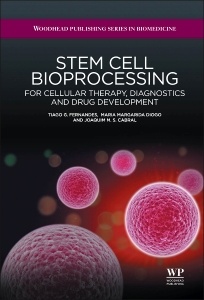Description
Stem Cell Bioprocessing
For Cellular Therapy, Diagnostics and Drug Development
Woodhead Publishing Series in Biomedicine Series
Authors: Fernandes Tiago G., Diogo M. Margardia, Cabral Joaquim M.S.
Language: English
Subjects for Stem Cell Bioprocessing:
236 p. · 15.5x23.2 cm · Hardback
Out of Print
Description
/li>Contents
/li>Biography
/li>Comment
/li>
List of figures
List of tables
Acknowledgments
About the authors
Chapter 1: Characteristics of stem cells
Abstract:
1.1 Introduction
1.2 Stem cell specialization
1.3 Stem cell types and functions
1.4 Signaling dynamics and stem cell pluripotency
1.5 Novel technologies and clinical applications
1.6 References
Chapter 2: Stem cell culture: mimicking the stem cell niche in vitro
Abstract:
2.1 Introduction
2.2 Stem cell niches
2.3 Niche components and structures
2.4 Engineering the microenvironment
2.5 Conclusions and future directions
2.6 References
Chapter 3: Bioreactors for stem cell culture
Abstract:
3.1 Introduction
3.2 Stem cell isolation and characterization
3.3 Critical issues in stem cell bioprocess development
3.4 Bioreactor design and operation
3.5 Bioreactor configurations
3.6 Bioprocess monitoring and control
3.7 Stem cell cultivation in bioreactors
3.8 Conclusions and final remarks
3.9 References
Chapter 4: Stem cell separation
Abstract:
4.1 Introduction
4.2 Overview of cell separation techniques and strategies
4.3 Stem cell-based separation methods
4.4 Conclusions and future trends
4.5 References
Chapter 5: Microscale technologies for stem cell culture
Abstract:
5.1 Introduction
5.2 Types of microscale technologies
5.3 Microscale platforms for cell culture
5.4 High-throughput and combinatorial screening applications
5.5 Stem cell research
5.6 Conclusions and future trends
5.7 References
Chapter 6: Stem cells and regenerative medicine
Abstract:
6.1 Introduction
6.2 Sources of cells for regenerative medicine
6.3 Cell processing for regenerative medicine: regulatory guidelines
6.4 Regenerative medicine and cellular therapy applications
6.5 Conclusions and future developments
6.6 References
Conclusions
7.1 Concluding comments
7.2 References
Index
Dr Maria Margarida Diogo received her PhD degree in Biotechnology from Instituto Superior Técnico (IST) from January 2000 to April 2004. Her thesis was dedicated to the development of Bioprocesses for Production and Purification of Plasmid DNA for Gene Therapy and DNA vaccines. As a result of this work, a United States Patent was published in 2007. From April 2004 to March 2008 she received a post-doctoral fellowship to work in the field of Stem Cell Bioengineering and she is presently a Research Scientist at the Stem Cell Bioengineering Laboratory at Instituto Superior Técnico (IST).
Dr Joaquim M. S. Cabral is Professor of Biological Engineering, in the Department of Bioengineering at Instituto Superior Técnico (IST), Technical University of Lisbon, Portugal. He was the founder and current Head of Department of Bioengineering, and the Director of the Institute for Biotechnology and Bioengineering, a Research Laboratory Associated to the Ministry of Science, Technology and Higher Education in Portugal. His research aims at contributing to biochemical engineering science through novel developments in Bioprocess Engineering and Stem Cell Bioengineering.
- Maintains a unique focus on both the basic stem cell biology concepts, and their translation to large-scale bioprocessing approaches
- Envisages the use of stem cells in regenerative medicine and drug screening applications
- Discusses the application of microscale techniques as a tool to perform basic stem cell biology studies
These books may interest you

Stem CellsTherapeutic Applications 189.89 €

Stem CellsTherapeutic Applications 189.89 €


